Pope Francis, the first Pope from Latin America, has died today at the age of 88.
While the Catholic Church’s highest authorities will soon gather to elect his successor, the Vatican currently has a more pressing priority.
With the weather in Rome remaining warm and humid, the Pope’s body will need to be embalmed to prevent the rapid onset of decay.
Although the details of this process have historically varied from Pope to Pope, Pope Francis’ body will likely be drained of blood and flooded with preservative chemicals.
Veins will be opened in the Pope’s neck and a mixture likely containing dyes, alcohol, water, and formaldehyde will be pumped in.
Just like a blood transfusion, this preservative mixture will wash through the circulatory system and push out the congealed blood which would lead to decay.
The formaldehyde mixture will then kill any remaining bacteria and ‘bind’ the proteins in the Pope’s cells to prevent the body’s own enzymes from breaking them down.
This process will allow the Pope’s body to lie in state for three days and be visited by hundreds of thousands of worshippers without showing obvious signs of decomposition.
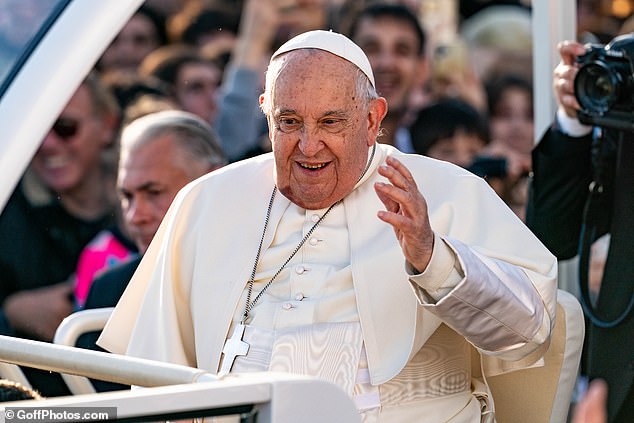
Pope Francis (pictured), the first Pope to be born in Latin America, died today at the age of 88. The Vatican now faces the pressing challenge of preparing his body to lie in state
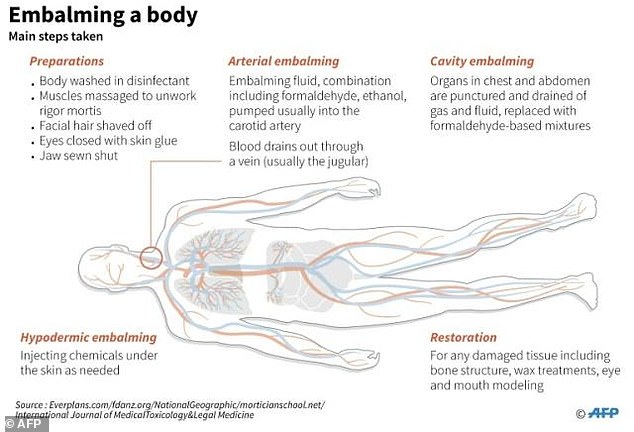
In an embalming process, veins are opened on the neck and a mixture of formaldehyde and dyes is injected into the circulatory system. This process pushes out fluids which could cause decay and kills any harmful microorganisms
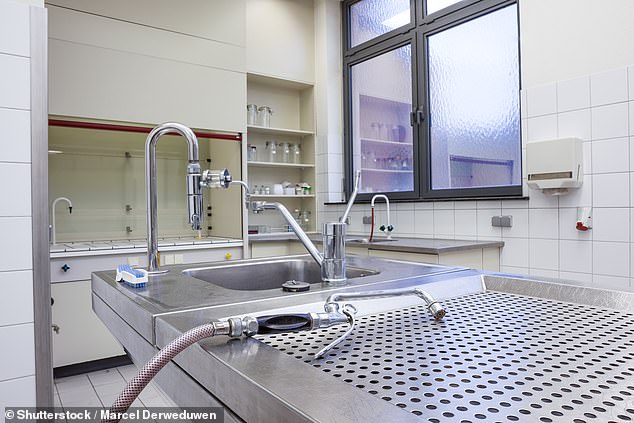
Since the 20th century, most Popes have received a modern embalming process. This involves replacing their bodily fluids with embalming liquids to slow down the process of decay (stock image)
In the past, the bodies of deceased Pontiffs were prepared with traditional methods, which included removing the organs and rubbing the skin with herbs and oil.
The body might have also been washed with lye to help it dry while the orifices would have been stuffed with herbs, cotton, and wax to prevent putrid fluids flowing out during the viewing.
However, since the 20th century, the Vatican’s funeral practices have shifted to be more in line with conventional embalming methods.
Dr Nikola Tomov, an anatomist from the University of Bern, explains in a research paper that the first pope to receive a ‘modern’ embalming was Pope Pius, who died in 1914.
When Pope Pius’ body was exhumed it was found that he had been treated with a chemical mixture that turned the body brown – despite his specific wishes to not be embalmed.
But the shift to modern methods was cemented by the disastrously botched embalming of Pope Pius XII, who died in 1958.
Papal physician Riccardo Galleazi-Lisi, who was in charge of the process, believed he had discovered the method used to preserve Jesus’ body.
Instead of keeping the body cool or draining the fluids, Galleazi-Lisi placed Pius XII inside a plastic bag to which he added herbs, spices, oils, and resins.
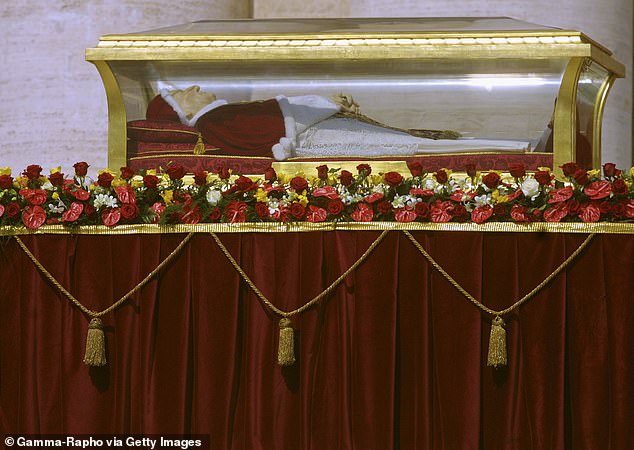
The embalmed body of Pope John XXIII at the Vatican on June 2, 2001. When he died in 1963, John XXIII’s body was infused with around 10 litres of embalming liquid before his face was covered with a thin layer of wax
This dramatically accelerated the putrefaction process, and the body decayed to such an extent that the Swiss Guard standing guard had to be rotated every 15 minutes due to the smell.
Since that disaster, the preparation of Papal bodies has largely followed the standard processes of modern morticians.
In a typical embalming process, the body is first thoroughly washed to remove any bacteria which may be on the surface.
As rigor mortis sets in, the stiffening of the muscles after death, the body will become rigid, and the jaw forces the mouth open.
The mortician will perform a number of cosmetic processes to make the deceased appear as natural as possible.
This typically includes sealing the eyes shut with plastic eye caps and wiring the jaw shut.
Pieces of cotton might also be tucked into the jaw and around the mouth to build up a relaxed expression rather than the ‘scowl’ which can be created by the wiring process.
In some cases, the body might need to be massaged to loosen the muscles in order to arrange the deceased into a reclining position.

The process of embalming for the Pope has varied historically, so it is not yet entirely certain how Pope Francis’ body will be treated
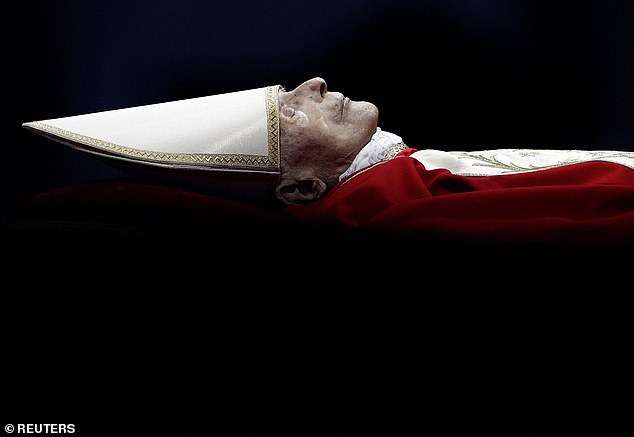
The Pope needs to lie in state for three days after his death and will be visited by hundreds of thousands. It is therefore essential that the body does not start to smell or obviously decay. Pictured: Pope Benedict XVI lying in state in St Peter’s Basilica at the Vatican, January 3, 2023
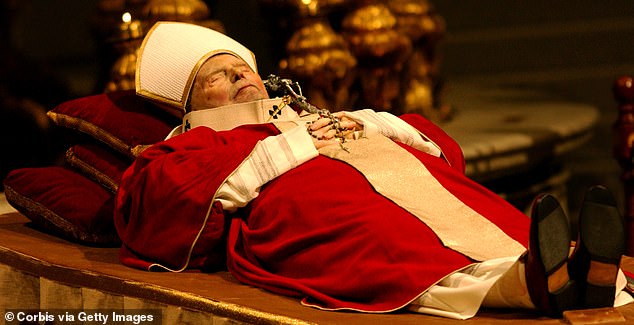
Pope John Paul II was only ‘prepared’ for lying in state rather than being embalmed according to the Vatican
Once the body has been arranged the mortician will then make a small incision just above the collarbone and pull out the carotid artery and jugular.
The blood vessels are then cut open and connected to an embalming machine, pumping an embalming fluid in through the carotid artery and pushing blood out of the jugular.
This liquid is typically a mixture of preserving agents such as formaldehyde and alcohol as well as dyes which give the body a more life-like colour.
Next, a large needle-like vacuum is inserted into the abdomen and used to extract all of the fluid and intestinal contents before more embalming liquid is pumped inside.
It is important that all the bodily fluids are removed both to make room for the embalming fluid and to remove any harmful microbes that would start breaking down the body.
Historically, the organs of the dead pope would be removed to help preserve the body and were sometimes embalmed separately to create religious relics.
The Church of Saints Anastasio and Vincent, near the Trevi Fountain in Rome, holds the preserved liver, spleens, and pancreas of 22 different popes.
However, unlike an Egyptian mummy, no Pope has had their organs removed since Pope Leo XIII when he died in 1903 after it was ruled that the Pope’s body must stay intact.
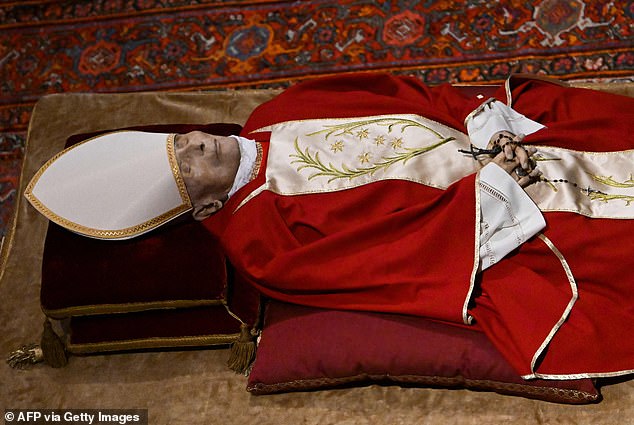
In line with tradition, Pope Francis will lay in state inside St Peter’s Basilica (pictured is Pope Benedict laying in state in January 2023). However, Pope Francis will lie in his coffin rather than on a raised platform
It is now even forbidden for the Pope to donate organs to the sick and dying after their death on the grounds that their body belongs to the Church.
Once all of the incisions have been sealed, the body is then washed, dressed, and prepared for presentation.
According to Massimo Signoracci, whose family has embalmed Popes dating back to Pope John XIII, this has been the process for most modern Popes.
For example, Mr Signoracci infused the body of Pope John XXIII with 10 litres of a mixture containing ethyl alcohol, formalin, sodium sulphate and potassium nitrate – a chemical typically used to cure bacon.
Speaking to Der Spiegel in 2005, he said: ‘After 37 years, (Pope) John XXIII looked just as good as he did on the day after his death.’
However, according to the Vatican, some more recent Popes have not been embalmed at all.
According to the Vatican, Pope John Paul II was not embalmed at all but merely ‘prepared’ for lying in state when he died in 2005.
It is not yet clear which of these options Pope Francis will receive, but he has already made some steps towards simplifying the Papal funeral procedure.
After preparation, the body of the Pope will then be dressed in red robes with a white mitre on his head, and he will be taken to St Peter’s Basilica, where he will lie in state for three days.
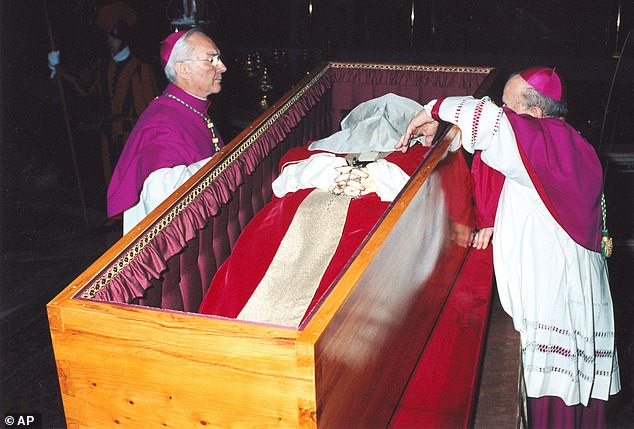
Pope John Paul II was buried beneath St Peter’s Basilica inside three coffins including one made from lead – nested inside each other
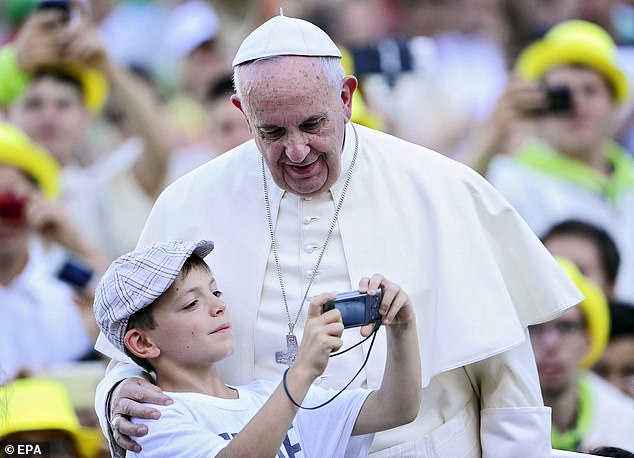
Breaking with tradition, Pope Francis (pictured) will be buried in a single wooden coffin lined with zinc rather than the traditional lead-lined coffin
Three caskets had traditionally been used for burying popes to create an airtight seal around the late pontiff’s body. They also allowed for objects, such as coins or papers issued by the pope during his reign, to be buried with the body.
Francis’s predecessor Pope Benedict XVI was buried in three coffins including one made from lead – nested inside each other.
Benedict lay in state inside St Peter’s Basilica and was then buried in a crypt underneath the building.
However, in a break from tradition, new rites issued last year said Francis would be laid to rest in a single zinc-lined wooden casket.
The pontiff also scrapped the tradition of placing the Pope’s body on a raised platform – known as a catafalque – in St Peter’s Basilica for public viewing.
Instead of resting on a catafalque in St Peter’s during the lying-in-state period, Francis’s body will lie in his coffin, which will remain open until the night before his funeral, Vatican News reported.
Francis will also be the first Pope in more than a century to be buried outside the Vatican.
Unlike his predecessors, the Pope said he did not want to be buried in the grottoes beneath St Peter’s Basilica at the Vatican.
Pope Francis used to pray at the basilica of Santa Maria Maggiore before and after trips overseas.
He made more than 100 visits to the fifth-century church, where he would pray in front of a sacred image of the Virgin Mary and baby Jesus.
At the end of 2023, the pontiff revealed he had ‘already prepared’ his tomb in the Basilica of Santa Maria Maggiore in Rome’s Esquilino neighbourhood.
The church is one of the four major papal basilicas and seven popes – from Honorius III in 1216 to Clement IX in 1669 – were buried there.
Francis will be the first pope in over a century to be buried outside the Vatican.
The last Pope to be buried outside St Peter’s was Leo XIII (1878-1903) who was interred in the Basilica of St John Lateran, which is the church for the Bishop of Rome.
As a result, 22 other Popes are also buried here while another four are also resting at the Basilica of St Lawrence Outside the Walls.
These include Blessed Pius IX (1846-1878), St Zosimus (417-418), St Sixtus III (432-440), St Hilary (461-468) and Damasus II (1037-1048).
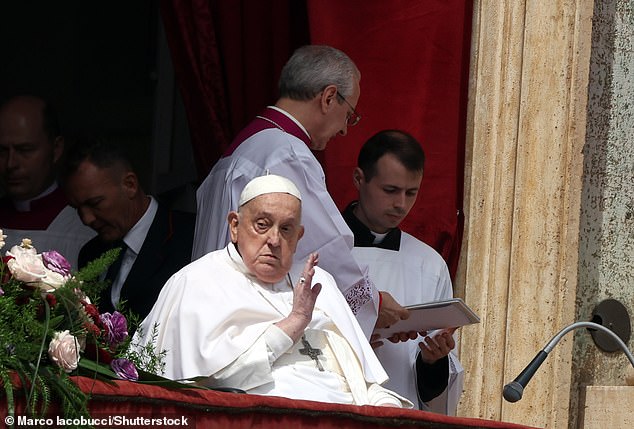
Pope Francis on the main balcony of St. Peter’s basilica during the Urbi et Orbi message and blessing to the city and the world as part of Easter celebrations yesterday
Almost all previous Popes, including Francis’s immediate predecessor Pope Benedict, are buried beneath St Peter’s.
Benedict’s body lay in state in St Peter’s Basilica from January 2 to January 4 2023, with around 195,000 mourners paying their respects. His funeral was attended by around 50,000 people.
Benedict was among the previous popes to be buried in the traditional triple coffin made of cypress wood, zinc and oak.
It was unprecedented in modern times for a living pope to bury his predecessor – a situation only made possible by Pope Benedict’s resignation in 2013.
The stripping back of the papal funeral procedure is intended to ‘to emphasise even more that the Roman Pontiff’s funeral is that of a shepherd and disciple of Christ and not of a powerful man of this world’, according to Monsignor Diego Ravelli, the master of liturgical ceremonies.







